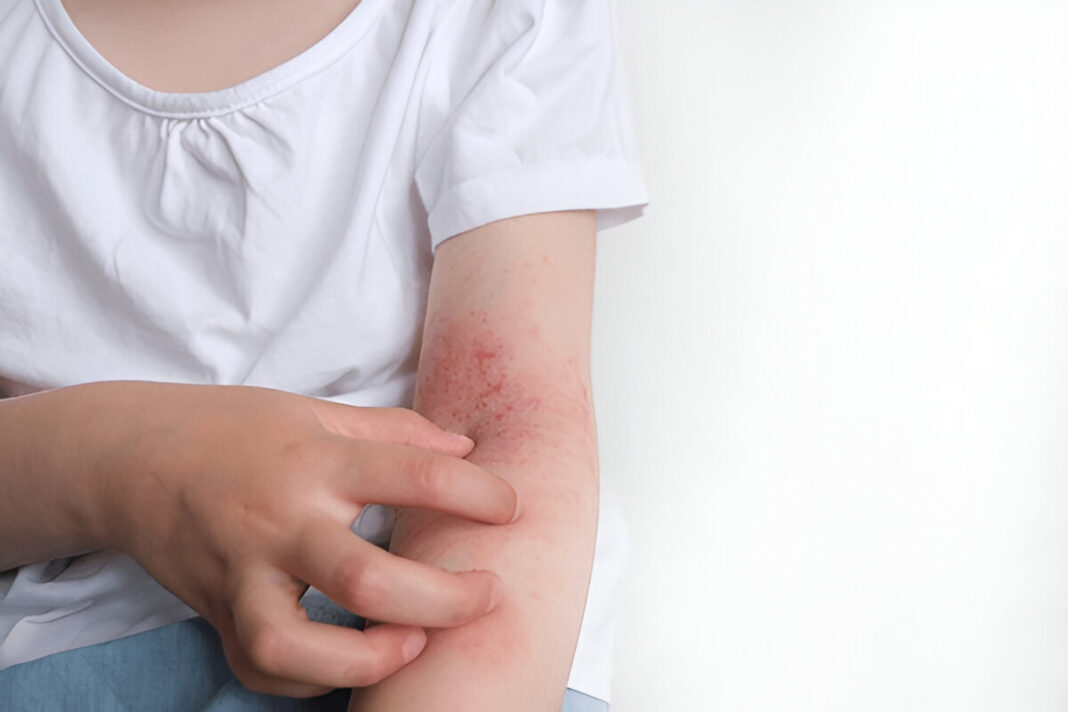Psoriasis, a chronic inflammatory skin disease, is often associated with adults, but it can and does affect children. It presents distinct challenges in diagnosis, emotional impact, and treatment. Pediatric psoriasis not only involves physical discomfort but can also significantly affect a child’s psychological and social development. Early recognition and a sensitive, tailored approach to treatment are essential for managing this complex condition effectively.
Understanding Pediatric Psoriasis
Psoriasis in children accounts for about one-third of all psoriasis cases, often appearing before the age of 16 (Bronckers et al., 2017). Like adult psoriasis, it is an immune-mediated condition that leads to rapid skin cell turnover and presents with red, scaly plaques. However, its appearance in children is often milder and more subtle, making diagnosis more challenging.
In pediatric cases, plaque psoriasis is the most common type, typically seen on the scalp, face, and flexural areas like the armpits and groin. Unlike adults, children may also experience guttate psoriasis more frequently, characterized by small, drop-like lesions following a streptococcal infection (Kimball et al., 2020).
Diagnostic Challenges
Diagnosing pediatric psoriasis can be difficult. Its symptoms often overlap with conditions like eczema, seborrheic dermatitis, and fungal infections. Because of its atypical presentation and children’s limited ability to describe symptoms, misdiagnosis is common. A thorough clinical examination, family history, and sometimes skin biopsy are crucial to confirm the diagnosis.
Pediatricians and dermatologists must also be sensitive to the psychosocial cues. Children may hide their lesions out of embarrassment or face bullying and exclusion, particularly in school settings.
Psychosocial Impact
Children with psoriasis are at increased risk of anxiety, depression, and low self-esteem. The stigma attached to visible skin conditions can interfere with school performance, friendships, and overall emotional well-being. Studies have shown that even mild psoriasis can profoundly impact quality of life in pediatric patients (Beattie & Lewis-Jones, 2006).
Hence, managing pediatric psoriasis goes beyond treating the skin. It requires a holistic approach that includes psychological support and counseling for both the child and their caregivers.
Treatment Considerations
The treatment of pediatric psoriasis must be both effective and safe for long-term use. The choice of therapy depends on the severity, location of lesions, age of the child, and psychosocial impact.
1. Topical Therapies: Topical corticosteroids are the first-line treatment for mild to moderate psoriasis. They help reduce inflammation and plaque formation. However, due to the risk of skin thinning and systemic absorption in children, long-term use should be monitored closely. Other topical options include calcipotriol (a vitamin D analog) and calcineurin inhibitors, especially in sensitive areas like the face or groin (Menter et al., 2020).
2. Phototherapy: Narrowband UVB phototherapy is effective for moderate to severe cases and has been safely used in children over the age of five. It’s a preferred option when topical therapies fail, offering symptom relief without the systemic side effects of oral medications.
3. Systemic Treatments: For more severe or refractory cases, systemic medications such as methotrexate, cyclosporine, or acitretin may be used, albeit with caution. These medications require regular monitoring due to potential liver, kidney, and immune system effects.
4. Biologics: Biologic therapies targeting specific immune pathways, such as tumor necrosis factor (TNF)-α inhibitors or interleukin (IL)-17 and IL-23 inhibitors, have revolutionized psoriasis care. Recent studies show these medications are both safe and effective in pediatric populations, particularly in moderate to severe cases (Paller et al., 2020). Agents such as etanercept, ustekinumab, and ixekizumab have received approval for pediatric use in various countries.
Best Practices in Pediatric Care
1. Individualized Treatment Plans: Each child’s treatment must be customized based on disease severity, age, comorbidities, and family preferences. Regular follow-ups are essential to adjust therapy and monitor for side effects.
2. Multidisciplinary Approach: Collaboration between dermatologists, pediatricians, mental health professionals, and school counselors ensures comprehensive care. Nutritional advice and weight management should also be part of the discussion, as obesity is a known exacerbating factor for psoriasis.
3. Family Education and Support: Educating families about the chronic nature of psoriasis, treatment expectations, and trigger avoidance, such as infections, stress, and skin trauma, is crucial. Empowering families helps ensure adherence and improves long-term outcomes.
Pediatric psoriasis presents unique challenges that demand a delicate balance between effective treatment and minimizing long-term risks. Beyond the visible symptoms, children face significant emotional and social hurdles. A patient-centered, holistic approach that addresses both the skin and the psyche is key. With growing advancements in pediatric dermatology, including safer systemic and biologic options, the future for children with psoriasis is becoming increasingly optimistic.
References
-
Beattie, P. E., & Lewis-Jones, M. S. (2006). A comparative study of impairment of quality of life in children with skin disease and children with other chronic childhood diseases. British Journal of Dermatology, 155(1), 145–151. https://doi.org/10.1111/j.1365-2133.2006.07185.x
-
Bronckers, I. M. G. J., Seyger, M. M. B., & de Jager, M. E. A. (2017). Psoriasis in children and adolescents: Diagnosis, management and comorbidities. Paediatric Drugs, 19(6), 447–458. https://doi.org/10.1007/s40272-017-0244-1
-
Kimball, A. B., Gieler, U., Linder, D., Sampogna, F., Warren, R. B., & Augustin, M. (2020). Psoriasis: Is the impairment to a patient’s life cumulative? Journal of the European Academy of Dermatology and Venereology, 34(5), 876–883. https://doi.org/10.1111/jdv.16055
-
Menter, A., Cordoro, K. M., Davis, D. M. R., Kroshinsky, D., Paller, A. S., & Elmets, C. A. (2020). Joint AAD-NPF guidelines of care for the management and treatment of psoriasis in pediatric patients. Journal of the American Academy of Dermatology, 82(1), 161–201. https://doi.org/10.1016/j.jaad.2019.08.049
-
Paller, A. S., Seyger, M. M. B., Alexandrescu, D. T., Hodge, J. A., Singh, R., & Kimball, A. B. (2020). Etanercept treatment for children and adolescents with plaque psoriasis. Journal of the American Academy of Dermatology, 62(1), 30–39. https://doi.org/10.1016/j.jaad.2009.05.027











